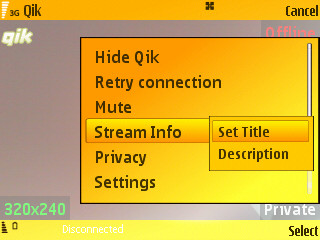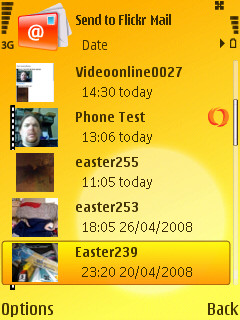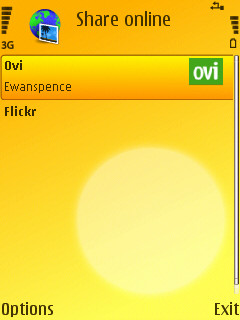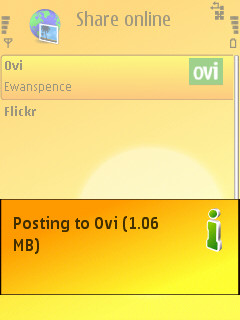We’re consistently told that the smartphones in our pocket, specifically the Nokia Nseries devices, are 'multimedia computers'… not phones. The hardware (megapixel cameras, almost DVD quality recording, 3G and Wifi data channels) shows that, but it’s the software that proves it.
Mobile video is one of the areas that a number of internet start-ups are looking at. Matching up the hardware on your device and an internet connection to a back-end web site and server on the internet, and you have the basis of a broadcast system.
Mobile video presents two differing options in getting video online. The first is streaming the video direct from our handset, typically through a piece of additional software, over an internet connection, to a central server (in other words, as close to live as possible). The second is to record the video on the handset first, and then upload that file to your video hosting service.
As yet, there isn’t an easy way to download and stream any video on another mobile device - many of the services here use flash video players using the latest version of Flash - that means that even mobiles running Flash Lite 3 won't be able to display the videos in the browser. Although that's the state of play just now, I'm sure that mobile to mobile video will be a feature in place on many sites by the end of the year. For the moment though, you're practically limited to real time viewing only on the desktop.
Flixwagon
There are already a number of services offering a very similar service to broadcast live – and Israel’s Flixwagon has already got notices in (used by Ricky Cadden to live stream his wedding… aww) and is typical of many online media services. Currently in alpha, Flixwagon is one of the current video sites that has a strong sense of community, allowing you to follow friends and interesting users, and to see who is following you in return.



The early adopter nature of video streaming means that there are not a huge number of users on these sites, but invariably those that are there are posting a lot of content. It's also nice to see that your video isn't just in Flixwagon, but can be copied to other services - something that most of the live streaming services will offer.
As with Qik (below), the quality of the streaming video, while still dependant on the hardware on the device, does cache itself and gets sorted out for a smooth archival video. Resolution is at a passable QVGA - enough to get over what you're up to, but don't expect it to be up there with broadcast TV just yet.
Qik
As with Flixwagon, Qik is still in testing (albeit a very public testing) so you’ll need to request an invite to the service by mailing the support team (more details on the Qik web site).


One of the great advantages of Qik is that, even though you are streaming from the phone, after the transmission and the video is moved to a playable archive, this video can then be cross posted to other web services, such as YouTube, Pownce and Blogger. This means that Qik, as well as storing your recorded videos online for later viewing, can also act as a waypoint to getting video out of your smartphone and into a number of services quickly and easily.
Qik has one major thing going for it – a buzz of publicity, primarily in the bloggers and commentators you would expect to be involved in the San Francisco Web 2.0 circles. This gave it the traction to have an influential (if still relatively small) user base who made a lot of noise about the service. Qik is good at what it does, and while the live video can be sometimes jerky due to slow network or Wi-fi coverage, the archived videos have all the pauses automatically edited out (a nice touch), and are easily linked to or embedded on other sites if you don’t take up the automatic re-posting option.
Look for Qik to continue to iron out bugs and open up for unfettered access at some point later this year. For all the buzz, it is one of the most polished options so far.

Shozu
While ShoZu doesn’t directly host any videos, or provide storage for your videos, what it does do is allow you to move your media from your smartphone to another service – it has templates set up to make posting your videos quick and easy to the largest collection of services I’ve seen. You set up your login details for these services on the ShoZu web site, these are uploaded to your phone (saves on typing) and then you can browse your phone’s contents and send up a file to the best service.
One useful option ShoZu has, if your service isn’t fully supported, is that it can upload to an FTP site or send an email with the media attached. A number of services allow this as a posting option, so you can use this for new services (and there’ll be an example in a moment).
The big problem that Shozu has with posting video is that there is a file size limit to anything that goes through the system – no file larger than 10MB will be sent. This wasn’t a huge problem when ShoZu was dealing solely in photographs and the occasional office file, but with video capture on the device, it’s very easy to blast through this limit, and there’s no correspondingly easy way to cut the file down to a suitable size.
If ShoZu could work round this problem then it’d be an invaluable tool - as it is, the service is a nice secondary option for video uploading if your preferred site doesn't have a dedicated mobile client, but its strength is still in photos, not video. As with most services, expect this to be addressed in the near future.

Flickr Video
Flickr is an immensely popular site for sharing your photos, and they recently added support for video as well. By limiting the uploaded videos to 90 seconds, they are pitching the changes to members as ‘long photos’ rather than videos and productions that you would see on services like YouTube.
Flickr does not offer their own upload service on a smartphone, and while Nokia’s ‘Share Online’ service does a grand job of sending pictures to Flickr, because the video service option is so new, it won’t allow you to send video through it… yet! But never fear, because there is an alternative.
Every Flickr account has an email address you set up, and anything emailed to that address will be posted to the account. This is the point where ShoZu comes in – set up a ‘send to email’ service in ShoZu with your Flickr Email account, and you’re all set.
Share on Ovi
And then there's Nokia's own solution. Part of the Ovi grouping of web services, Share Online (formerly Twango) does integrate into the Share Online service of your handset, opening up the icon in your gallery of videos to post directly to the service. And unlike Flickr, there is no artifical time limit imposed, nor is there a limit on the file size to be uploaded (a la the ShoZu route) - the usual caveats about having an unlimited data plan or Wi-Fi connectivity do apply though.
It's not surprising, though, that the service from the mobile phone manufacturer actually works with the mobile phone. As with any online service, the key is not just how easy it is to get your media online, it's about the friends that you have online, and how they (and you) can interact with your media - Share on Ovi offers the now de-facto interface of searchable tags and text, channels and collections of media, code to embed the video in a site, and also includes a location tag if your upload has that information.


Unlike other services it is important that Share on Ovi does not limit you to a single media type. Video and photos sit happily alongside audio clips (including Ogg Vorbis, which should keep Steve happy) and documents, which means it is a lot more flexible and more of a one stop shop than the other services discussed here. That will suit some users, but could put off others worried about having everything in a single place.
Summary
Video from your mobile is definitely a growth area over the next year, and no matter the economy, expect to see significant investment and funding in this area, which will lead to improvements in the web sites and the software on the phones. It’s going to be fun to watch as mobile hits up some of the problems older media already deal with – the obvious one is letting people know that you are broadcasting over the next few minutes.
At the moment most sites rely on the text and SMS-based Twitter service, but expect to see custom alert services built into these sites as they develop.
The key to all this is the computer, the high end computer, in your pocket. That power is opening doors that we could barely have imagined five years ago.
-- Ewan Spence, April 2008
